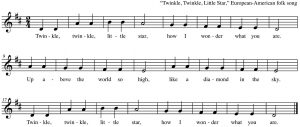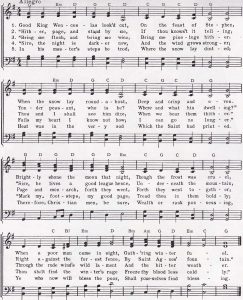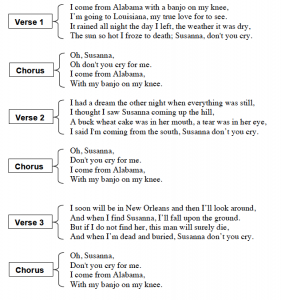Form
This unit offers a basic introduction to musical form — how compositions divide musical time into sections. Continuation, Repetition, and Contrast One of the simplest ways to distinguish the sections of a piece of music is to identify when a passage continues, when a passage is repeated, and when a new contrasting section is introduced. For example, consider the following widely known folk tune:
Note that the music continues through the first line (although there is in fact a slight pause at the word “star” in measure 4), then the second line introduces some contrasting material, and finally the third line repeats the music of the first line. Therefore, we can label the three sections of “Twinkle, Twinkle, Little Star”: We’ll call the first line A, the second line B, and the third line A again. In general, we’ll use upper-case letters to refer to the broadest sections of a piece.1 In addition, when dealing with music and lyrics, we’ll use upper-case letters to represent sections that repeat both music and lyrics, and lower-case letters to represent sections that repeat music with different lyrics (as in the different verses in a song).
Cadence and Phrase
Short passages in Western music are often punctuated by CADENCES — points of arrival or rest, often (although not always) where musicians would breathe before continuing. Consider the following excerpt: (click for high res)
Note that we labeled four sections in this excerpt, each four measures long. We label the first section A, which comes to a brief pause — a cadence — at the end of measure 95. Cadences are form-defining events. This one marks the end of a four-measure unit we’ll call the first PHRASE.
Note that the first phrase ends on ^2. Because this yields a feeling of incompleteness, we refer to this as an OPEN CADENCE. The next four measures (mm. 96-99) are very similar to mm. 92-95, differing only in the pitches of the last two notes. Because these two four-measure phrases begin the same way and are so similar, we’ll label the second phrase A’ (pronounced “A prime”).
Note that the first phrase ends on ^1. Because this yields a feeling of completion, we refer to this as a CLOSED CADENCE.
The third phrase (mm. 100-103) is different enough from the first two that we’ll give it a completely new label — B. Finally, the last four measures are a repetition of the first A’ (mm. 96-99), with only a small subtle rhythmic change (bringing in the Fs one beat early at the end of m. 103 and repeating it on the second beat of m. 104), so we’ll call this A’ again. Thus, this excerpt comprises four phrases: A A’ B A’.
Periods
Quite often, two phrases combine to make a PERIOD. There are several different kinds of periods, which are defined by the relationships between their component phrases.
This is the simplest type of period (so simple, that some don’t consider it to be a period at all!). The REPEATED PHRASE is just what it sounds like — a single phrase is simply repeated in its entirety:
Note that the pitches and rhythms of the first four measures of this Christmas carol are repeated exactly in the next four measures (although the lyrics do change). Because of this, we call this a REPEATED PHRASE.
Many times, the second phrase in a period begins the same way as the first one did, but then ends differently. We already saw (and heard) this in the first eight measures of the excerpt from the last movement of Beethoven’s Ninth Symphony:
The period consists of two similar phrases. We call the first phrase in this period the ANTECEDENT and the second phrase the CONSEQUENT. Note that the consequent phrase in the melody from Beethoven’s Ninth differs from the antecedent only in the way it cadences. The antecedent ends with an open cadence whereas the consequent ends with a closed cadence. This is typical of many antecedent-consequent pairs. Because of this, we label both phrases with the same letter (A): many theorists call this a PARALLEL PERIOD because of the parallels between the two phrases.
Sometimes, the phrases that makes up a period are so dissimilar that we give them completely different labels (such as A and B). A period that consists of two dissimilar phrases is generally called a CONTRASTING PERIOD. For example, consider the next two phrases from Beethoven’s Ninth:
Phrases can also combine into larger structures like ABA and A’A’BA‘, as described in this video:
Larger Forms for Songs
Music that includes text comes in various forms. On of the most common types come in VERSES, which repeat the same music with different lyrics; this is called STROPHIC form. We’ll examine two of the most basic varieties of strophic music. Verse-Repeating Form The simplest strophic form consists of two or more verses of text (poetic stanzas), with each verse set to the same music. Here is a complete score to “Good King Wenceslas.” Notice how the same music is used for each of the five verses: (click for high res)
Many hymns and pop songs use verse-repeating form. Even the twelve-bar blues (which we encountered in Unit 11) is a verse-repeating form, with different lyrics set to the same twelve measures of music. We could label the sections of verse-repeating songs as A A’ A” and so on. We could also label them A a a, with each lower-case letter representing new lyrics.
Verse-Chorus Form
Sometimes, after each of some or all of the verses in a song there is a section in which both music and lyrics are repeated nearly or completely exactly each time the section returns. This section of the form is called the CHORUS. In VERSE-CHORUS form, verses and choruses repeat in alternation. For example, here are the lyrics to the song “Oh! Susanna”:
Here is how Stephen Foster set those three verses and three choruses to music: (click for high res)
All three lines of music are to be performed three times, but each time through the lyrics of a different verse should be sung. Many songs depart from strict verse-chorus alternation, particularly through presenting two verses before the first chorus, and through introducing other sections — such as an introduction and a contrasting middle section (often called a bridge). In addition, many songs insert one or more instrumental solos between sections, often following the basic musical structure of the verse.
Other larger forms include Simple Verse/Chorus, Two-Verse/Chorus, AABA, and Verse/Chorus/Bridge, each described in the following video:







